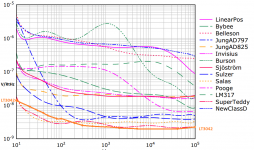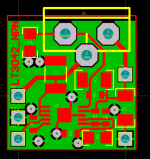It seems the voltage scale is somewhat weird?
yes, should be "Volts/RtHz"
with Cset=22u
It seems that the Sulzer measurement has the same problem that
Scott Wurcer spotted with my preamp: it is not 1/f.
Have the measurements all be done with the same setup?
All the measurements were done at the same time with the SSM2019 balanced preamplifier at a gain of 100. The AP has a filter factor of √0.2316 * F in the analog mode. So I wrote an AP basic macro to plot Volts/√Hz.
As a sanity test, I ran the tests and compared numbers to those in his 1995 articles. They seem to compare closely, although he was able to measure impedance lower than I witnessed.
As a sanity test, I ran the tests and compared numbers to those in his 1995 articles. They seem to compare closely, although he was able to measure impedance lower than I witnessed.
with Cset=22u
What implementation, circuit board wise, did the LT3042 enjoy at the time of your measurement?
//
What implementation, circuit board wise, did the LT3042 enjoy at the time of your measurement?
used a graphing program to take the data off the LTC datasheet.
All the measurements were done at the same time with the SSM2019 balanced preamplifier at a gain of 100.
Good. It is nearly meaningless to compare results copied together from
unspecified sources. That's why I did the series on lab supplies, references,
regulators and batteries.
The GR-noise-like appearance of the noise in the Sulzer does not need
to come from the measurement system, it can be just as well in the regulator
itself. From the circuit I just found on the tangentsoft site
< Op-Amp Based Linear Regulators >
I would guess that we just see the noise voltage of the 47K-resistor to the ninv-input
of the op amp that is not good enough filtered for really low frequencies by
the 1uF tantalum. That is easily and cheaply cured.
The -3dB frequency may be 3 Hz, but at -3 dB Xc is just == R, so there
is not much shorting of the resistor's noise voltage.
I must confess that I did the same mistake in the input coupling of my preamp
and Scott spotted it immediately.
Reading the website article, I find it kinda funny how names are attached to
textbook circuits and they are carefully updated, as if soldering a LM317 in front
of another regulator was the culmination of patent-worthy IP that required
a new name. That does not apply to the Jung reg.
regards, Gerhard.
Last edited:
Are there similar comparisons made for output impedance (which is probably often a more important parameter)?
//
//
Are there similar comparisons made for output impedance (which is probably often a more important parameter)?
//
check out the download section on www.linearaudio.net
I have a Philips CD753 player and want to use a better regulator. The CD player only has one - L7805CV regulator. I was wondering if something like a LM2950-5v any thoughts ? Thanks 🙂


My experience with 5V integrated regs in digital
I found LM2940T5 best in a multiple integrated reg comparison.
See http://www.diyaudio.com/forums/digi...c-kit-cs8416-ak4393-5532-a-6.html#post2541019
I found LM2940T5 best in a multiple integrated reg comparison.
See http://www.diyaudio.com/forums/digi...c-kit-cs8416-ak4393-5532-a-6.html#post2541019
I would use a LT1086-5
Oops. Didn't read my own post carefully. That is National LM340T5 that came out on top.
Thanks Sorr and Steely 🙂 for the help.
I would use a LT1086-5
Use an LT3042 and an outboard PNP or NPN transistor. The LT1086-5 isn't even remotely in the same ballpark.
Use an LT3042 and an outboard PNP or NPN transistor. The LT1086-5 isn't even remotely in the same ballpark.
Suggestion for a complementary rail?
Use an LT3042 and an outboard PNP or NPN transistor. The LT1086-5 isn't even remotely in the same ballpark.
I have made a tiny layout for the npn circuit in the data sheet.
I have no idea of a negative version that does not have at least
2 op amps.
It will take some time until I can test that. A lot of stuff in the pipeline
in front of it.
regards, Gerhard
Attachments
Last edited:
Use an LT3042 and an outboard PNP or NPN transistor. The LT1086-5 isn't even remotely in the same ballpark.
I thought he just wanted to unsolder the existing 3 reg and replace it another, but better 3 pin reg.
- Home
- Amplifiers
- Power Supplies
- Best low noise regulator?

